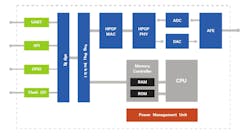The Qualcomm Atheros QCA7000 offers a simplified solution as it includes all of the components needed for a PLC modem, such as the analog front end, power-management unit, and RAM and ROM. UART and SPI interfaces are provided as well. GPIO allows external circuits and devices to be connected. External flash is an option.
The Qualcomm Atheros QCA7000 IC is a fresh new solution for the use of power-line communications (PLC) in home energy networks. Wireless solutions are available, but PLC approaches are an obvious good choice since the communications medium, your ac power wiring, is already in place.
While using the ac power line as a communications link seems to be a no-brainer, its quirky, noisy characteristics have made designers wary. The QCA7000 addresses and solves these problems and does it with low power consumption.
The QCA7000 is designed for home area networks (HANs). Target devices include smart meters, home energy management systems, appliances, and electric vehicle charging stations. It’s based on the new HomePlug Green PHY (HPGP) standard from the HomePlug Alliance.
HomePlug is one of the oldest and most widely used PLC standards. It is known primarily for HomePlug AV, which can achieve data rates greater than 200 Mbits/s for connecting TV sets, DVD players, set-top boxes, and other consumer electronic devices. HPGP uses the same orthogonal frequency-division modulation (OFDM) scheme and band plan but offers features that better fit the needs of a HAN.
HPGP is an innovative standard for PLC that’s interoperable with the IEEE 1901/HomePlug AV power-line networking protocol. It swaps the HomePlug AV protocol’s greater than 200-Mbit/s rate for low-energy, low-cost extended home coverage. This tradeoff can equate to a more than 80% power reduction in a given application while providing up to a 10-Mbit/s data rate to meet today’s smart energy needs for scalability to protect investments for future requirements.
Also, HPGP is an IP-based (Internet protocol) technology that enables the handling of IP protocols, such as Smart Energy Profile (SEP) 2.0, without translation layers. It also can natively support media access controller (MAC) layer bridging to Wi-Fi, Ethernet, and cellular technologies, providing endless extensibility to the power-line network.
The QCA7000 is highly integrated with the power-management unit, analog front end, and memory in a tiny 8x8 quad-flat no-lead (QFN) package (see the figure). A single 3.3-V rail powers the chip to allow for reduced system cost and easy integration into customer designs.
To support embedded applications, SPI and UART host interfaces are available on the chip to permit direct connectivity to low-cost, low-power microcontrollers commonly found in the smart energy ecosystem. To reduce customers’ system cost, a GPIO bus and an optional flash interface are available to support simple hostless applications like smart plugs and monitoring sensors.
Samples of the QCA7000 chip are available now to select customers. Volume production is scheduled for early 2012.
Qualcomm Atheros
www.qca.qualcomm.com


